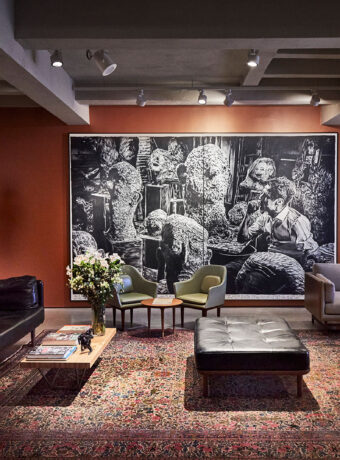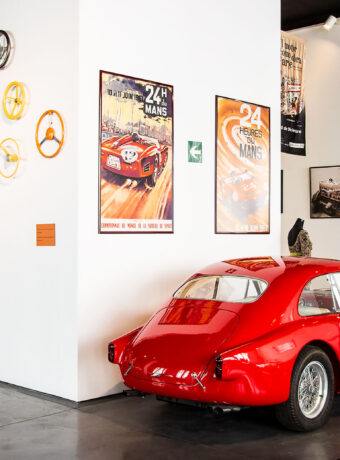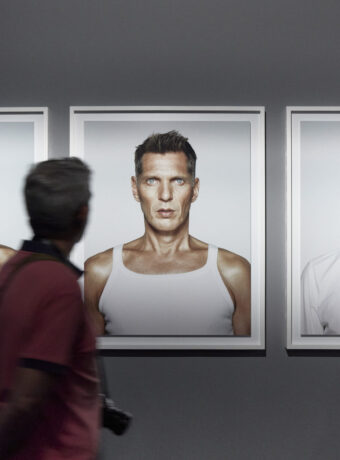The center of Oviedo is an outdoor art museum sprinkled with sculptures. Here you can meet everything from film director Woody Allen and a famous pop singer to a stray dog and a giant ass. Plus, you’ll get a different insight into Oviedo’s important personalities.
Photo: Christian Grønne
In the center of the Asturian capital, streets and squares are adorned with sculptures of all shapes and sizes, ranging from classic to ultra-modern. There are over a hundred sculptures. Most of them depict personalities or figures that have had a special meaning for Oviedo.
The idea of sprinkling Oviedo with sculptures was initiated by the city council in the late 1990s to create an open-air museum for its citizens. Most of Oviedo’s sculptures are created by local artists.
 1 Say hello to Woody Allen
1 Say hello to Woody Allen
Famed film director Woody Allen has a special relationship with Oviedo, and several of the city’s streets and buildings featured in his film Vicky, Cristina Barcelona (2008). In the movie, the main character, Juan (Javier Bardem), invites Vicky (Rebecca Hall) and Cristina (Scarlett Johansson) to Asturias to show them his homeland – and seduce them.
Woody Allen returns to Oviedo again and again, staying at the Eurostars Hotel De La Reconquista.
In 2002 Woody Allen received the ‘Príncipe de Asturias’ award for his art and in 2003 the city even erected a bronze sculpture of him. It stands on a side street of the city’s main shopping street, Uria.
Next to the sculpture is a plaque with a quote Allen said about the city:
“Oviedo is a delicious city, exotic, beautiful, clean, pleasant, calm and pedestrian-friendly, as if it doesn’t belong to this world, as if it didn’t exist… Oviedo is like a fairy tale”
Monumento a Woody Allen, Calle Milicias Nacionales 1
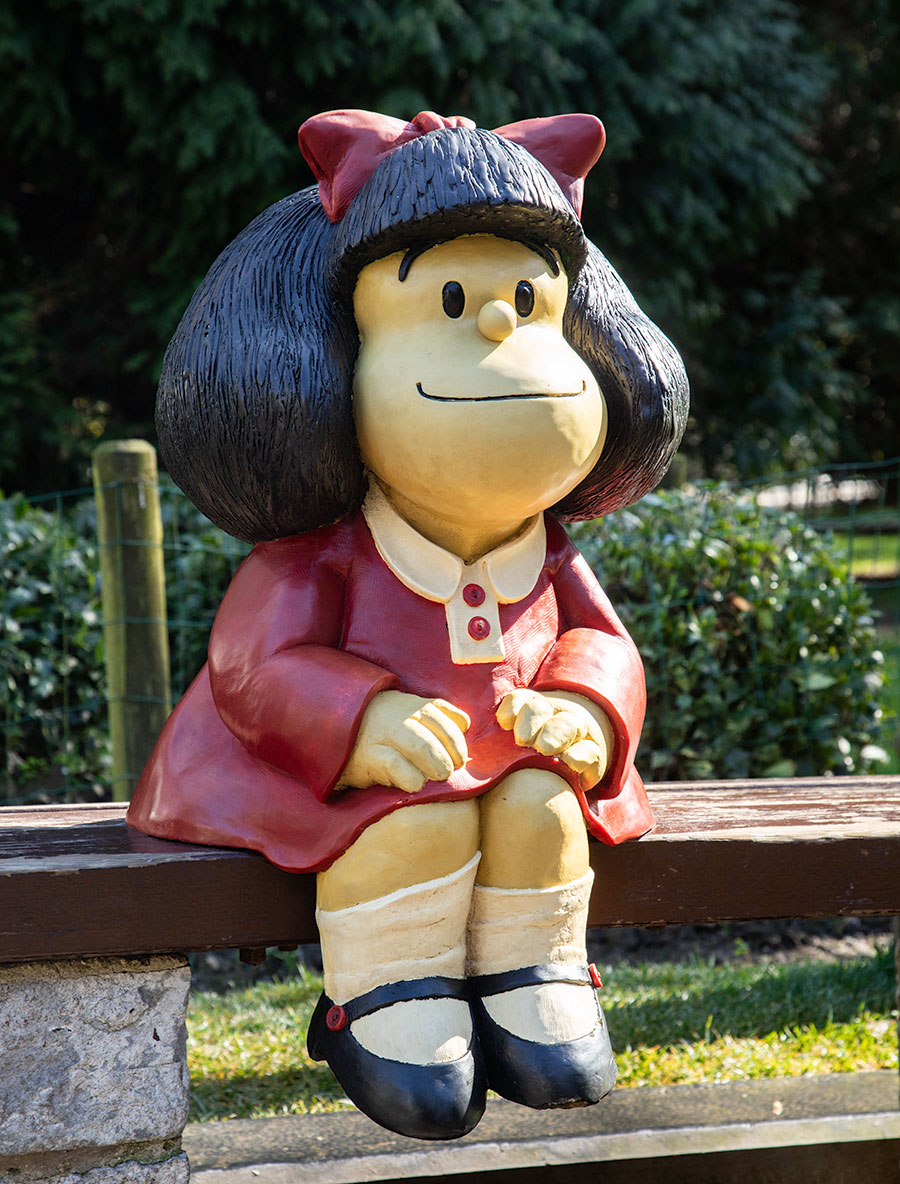 2 Meet the naughty cartoon character
2 Meet the naughty cartoon character
In Oviedo’s most visited city park, San Francisco, the mischievously smiling cartoon character Mafalda sits in her red dress on a bench opposite the park’s duck pond. The park is close to the street with the Woody Allen character, and he and Mafalda are the two most visited sculptures in the city.
Most Spanish children know and love Mafalda, an Argentinian cartoon created by Quino (1932-2020) in 1964, which he developed over a number of years.
Mafalda was four years old when the cartoon began and from the start she was always interested in world events, which she watched with great concern. She asked lots of – and often inappropriate – questions to the adults about social norms, women’s rights and politics. Despite her pessimism, she had a sense of humor and an unshakeable belief that there could be peace and order in the world.
Created by Argentinian sculptor Pablo Irrgang in 2014, the sculpture is made of clay, covered with fiberglass and resin. In the same year, Quino was awarded the Príncipe de Asturias prize.
Mafalda, San Francisco Park
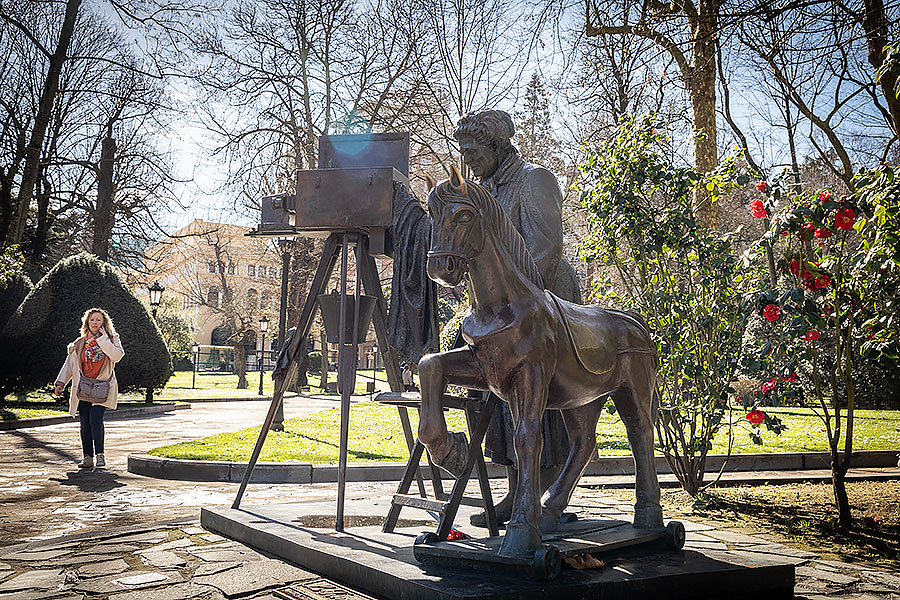 3 The portrait photographer
3 The portrait photographer
At the entrance to San Francisco Park, on Avenida de Italia, facing Uría Street, stands another sculpture that is also loved by children because they can climb on it. La Torera (The Bullfighter) depicts life-size photographer Josefa Carril with her camera, tripod, a bucket of water, a chair and a small toy horse.
Josefa Carril was a popular photographer who lived in Oviedo and who, together with her husband Antonio Hernández, photographed the city’s bourgeoisie at this very spot in the park. Josefa’s cardboard horse would keep the children occupied while she took her portraits.
La Torera, San Francisco Park
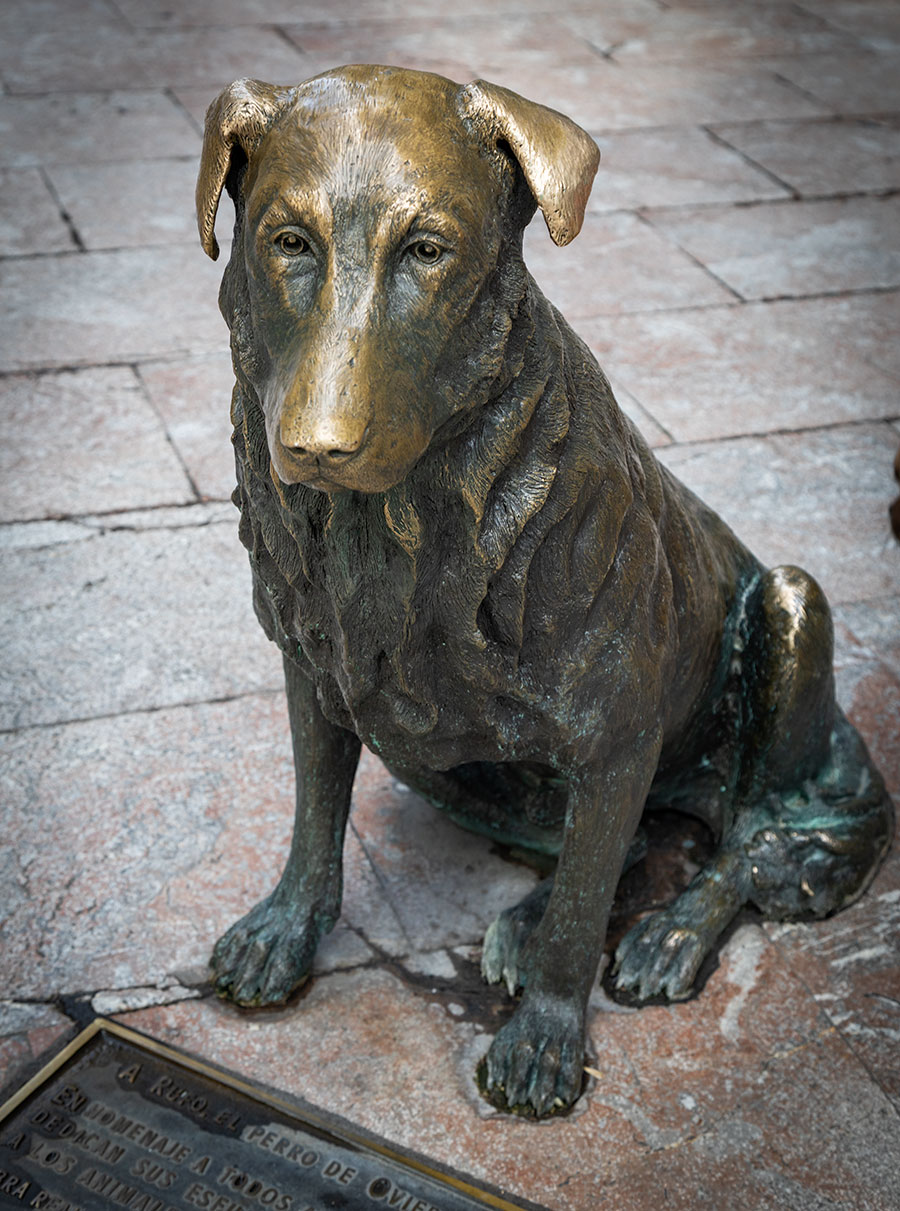 4 Oviedo’s beloved dog Rufo
4 Oviedo’s beloved dog Rufo
El Perro de Oviedo (Oviedo’s dog) stands out from the crowd of Oviedo sculptures because it has a special story attached to it.
Rufus, a cross between a German Shepherd and a Mastiff, appeared in the San Francisco park in 1988 when he was just a puppy. He was a stray, but quickly charmed his way into the hearts of the city’s citizens, who made sure he got plenty of love and food.
At one point, the municipality impounded Rufus because they didn’t want him running around the streets. This led to huge protests from citizens, so the municipality ended up having Rufus vaccinated, dewormed and released back into the wild.
Rufus became part of the city’s many parties and events, where he always showed up. He slept in the city gates. He also managed to become a father and grandfather before being sent to a boarding school in his old age, where he was cared for until his death in 1997.
The sculpture of Rufus was created with donations from the “Friends of Rufus” association to honor the city’s homeless dogs. It was created in 2015 by sculptor Sara Iglesias Poli. You can greet Rufus on Dr. Casal Street, which is close to San Francisco Park.
Rufo, El perro de Oviedo, Calle Dr. Casal 3
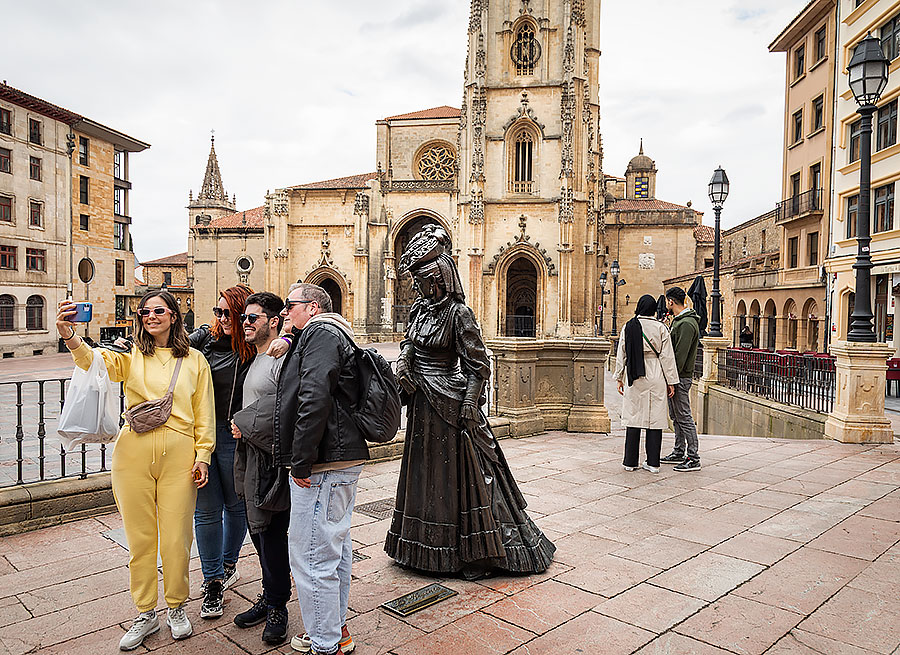 5 The Regent steps out of the novel
5 The Regent steps out of the novel
In the square in front of Oviedo’s cathedral, a bronze sculpture depicting the important Spanish novelist Ana Ozores, also known as La Regenta (The Regent), has become a part of everyday life for locals and is frequently Instagrammed by tourists.
The character Ana Ozores appears in the 1884 novel La Regenta by Spanish author Leopoldo García-Alas y Ureña. The book, which has become an important part of Spanish literary history, explores themes such as love, religion and social norms through the protagonist. The novel is set in the fictional town of Vetusta, which is inspired by Oviedo, and therefore particularly significant for the city.
Artist Mauro Álvarez Fernández depicts a thinking Ana Ozores in the almost two meter high and 200 kg sculpture from 1997.
La Regenta, Plaza de la Catedral
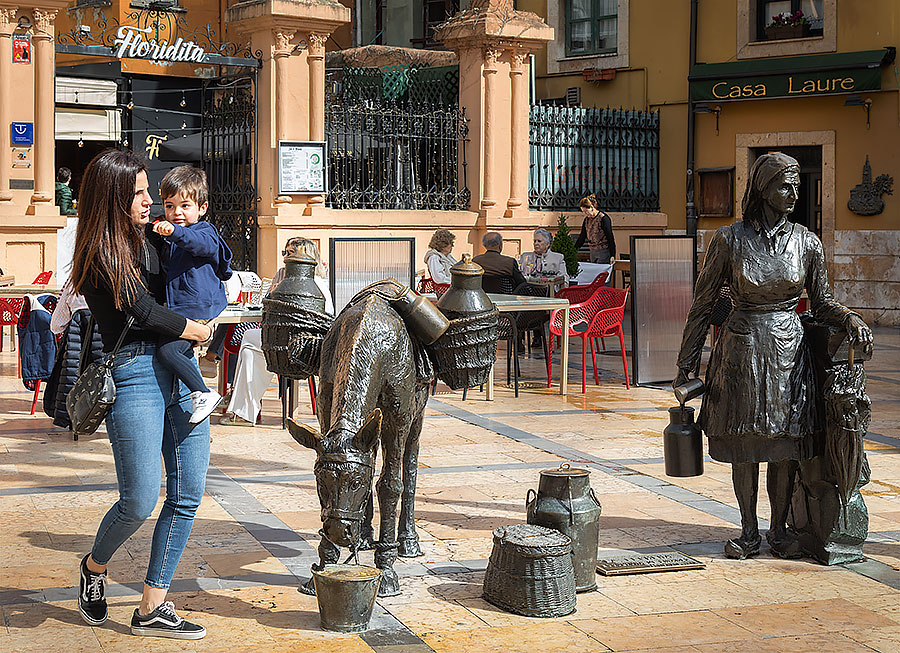 6 The milkmaid and the donkey
6 The milkmaid and the donkey
In the heart of Oviedo is the Instagram-worthy Trascorrales square, surrounded by colorful houses with restaurants on the ground floor. Locals call it Plaza de la Burra (Donkey Square) in reference to one of the city’s most beloved bronze sculptures, La Lechera (The Milkmaid), which children love to play on.
Artist Manuel Garcia Linares has created an old-fashioned dressed milkmaid with her donkey, laden with heavy milk jugs and her forelegs tied, drinking water from a bucket. The work from 1996 is a tribute to the women who until the 1970s came to the city with their donkeys to sell milk.
La Lechera, Plaza de Trascorrales
 7 The fishergirl
7 The fishergirl
In another corner of Plaza de Trascorrales, opposite the oval building, stands another sculpture Pescadera (the fishergirl), created in bronze by local artist Sebastian Miranda in 2005.
The sculpture depicts a seated young woman holding a bucket of fish by her legs. Some of the fish have “jumped” out of the bucket, illustrating that the fish being traded were fresh and newly caught.
The oval building opposite once housed the town’s fish market, so it’s no coincidence that the sculpture is located here.
Pescadera, Plaza de Trascorrales
 8 The sellers in the marketplace
8 The sellers in the marketplace
Las Vendedoras del Fontán (The Vendors of the Fontán) is another of Oviedo’s sculptures depicting some of the city’s historic merchants. It depicts two women who have traveled from the countryside to Oviedo with their pottery and household goods to sell them at the market.
The sculpture is from 1996 and is made of bronze by the artist Amado González Hevia. It stands in Plaza Daoíz y Velarde, adjacent to Plaza del Fontán. Both squares have been home to the city’s markets for generations. Today, markets are held here on Thursdays and Sundays.
The sculptor found the idea for the sculpture in an old photograph. One of the women was sitting and smoking in the photo, but that detail was changed to her holding a jar in her hands.
Las Vendedoras del Fontán, Plaza Daoíz y Velarde
 9 Young women reading
9 Young women reading
Under the lamppost that illuminates the main entrance to the Campoeamor Theater, a young woman is immersed in a book that she holds in her hands. In the other hand she holds a folder.
She is absent-minded, expressing calm, seriousness and something dreamy. Some argue that she appears romantic and more dreamlike than realistic.
The sculpture of the young woman is called Esperanza Caminando (Hope to Walk) and was created by Julio López Hernández in 1998. Some believe it is a reference to Oviedo being a university town.
Esperanza caminando, CallePelayo, in front of Teatro Campoamor
 10 A good ass
10 A good ass
Right next to the Campoeamor Theater is Oviedo’s biggest ass in the form of the sculpture Culis Monumentalibus, also known as El Culo (the ass). The four meter high sculpture was created in black bronze mortar by artist Eduardo Úrculo in 2001.
Symbolically, there is more to it than the buttocks and legs that the eye first catches. If you look at the sculpture from a different angle, it turns out to depict two posteriors, back to back. Ùrculo had a particular passion for painting donkeys, so many believe this was the artist’s subject.
The sculpture is made of black mortar bronze and weighs over 900 kilos.
Culis Monumentalibus, Calle Pelayo
 11 Tribute to moms
11 Tribute to moms
Close to the Campoamor Theater you’ll also find the large sculpture of motherhood, La Maternidad, which sits lushly in the lively Escandalera Square. The sculpture depicts a naked, lush woman with her naked son on her lap.
La Maternidad is one of the most popular sculptures in Oviedo among the locals, who also call it La Gorda (the fat one). It’s not unlikely to hear the following phrases on the street: “I’ll meet you at the fat one”.
The lush and sensual sculpture is a tribute to motherhood and was created by artist Fernando Botero in 1989. However, it only moved to Plaza Escandalera in 1996. The sculpture is two and a half meters high and weighs 800 kg.
La Maternidad, Plaza Escandalera 17
 12 The mysterious traveler
12 The mysterious traveler
In Plaza de Porlier, a mysterious man in a hat stands next to his suitcases, bag and umbrella. He is wearing a long coat, hat, mustache and a mysterious gaze directed towards the city cathedral. He looks like he’s stepped out of a film noir.
The sculpture depicts Williams B Arrensberg, who was a friend of the artist Eduardo Úrculo. It is titled El regreso de Williams B. Arrensberg (The Return of Williams B. Arrensberg), but is also called The Traveler.
The story behind Arrensberg and where he traveled and returned to is unknown, but the sculpture from 1993 is among the most popular in the city.
El regreso de Williams B. Arrensberg / El viajero, Plaza de Porlier
 13 Tino Casal
13 Tino Casal
Strolling down Oviedo’s Palacio Valdés shopping street, you’ll bump into iconic local pop singer Tino Casal (1950-91), whose real name was José Celestino Casal Álvarez.
As well as being one of Spain’s most famous pop singers of the 1980s, Tino Casal was known for his eye-catching costumes and stage shows. He was also an active member of the cultural movement La Movida Madrileña alongside Pedro Almodovar and others.
Tino Casal has written and produced music in the genres of pop, glam rock and heavy metal and has won several awards for his music. Later he also took up painting. He died at the age of 41 in a traffic accident.
Anselmo Iglesias Poli recreated Tino Casal with one of his iconic hats and gloves in the 1.97 meter tall sculpture from 2019. Oviedo’s sculpture of Casal was funded by musicians and others through proceeds from concerts.
Tino Casal, Calle Palacio Valdés 15
 14 Demonstrative women and men
14 Demonstrative women and men
In Plaza del Carbayón, seven naked women and men stand in a row, turning their androgynous faces in different directions. The Monumento a la Concordia, also called Cabeza de manifestación (demonstration leader) depicts people turning their heads away in protest.
The sculpture was made by Madrid-born artist Esperanza d’Ors in 1997. It stands in front of the Teatro Campoamor, where the Príncipe de Asturias award is presented every year.
Monumento a la concordia, Plza del Carbayón
More travel tips for Oviedo
Find inspiration for more experiences in the big Oviedo travel guide.
Read also the guide to the best hotels in Oviedo.
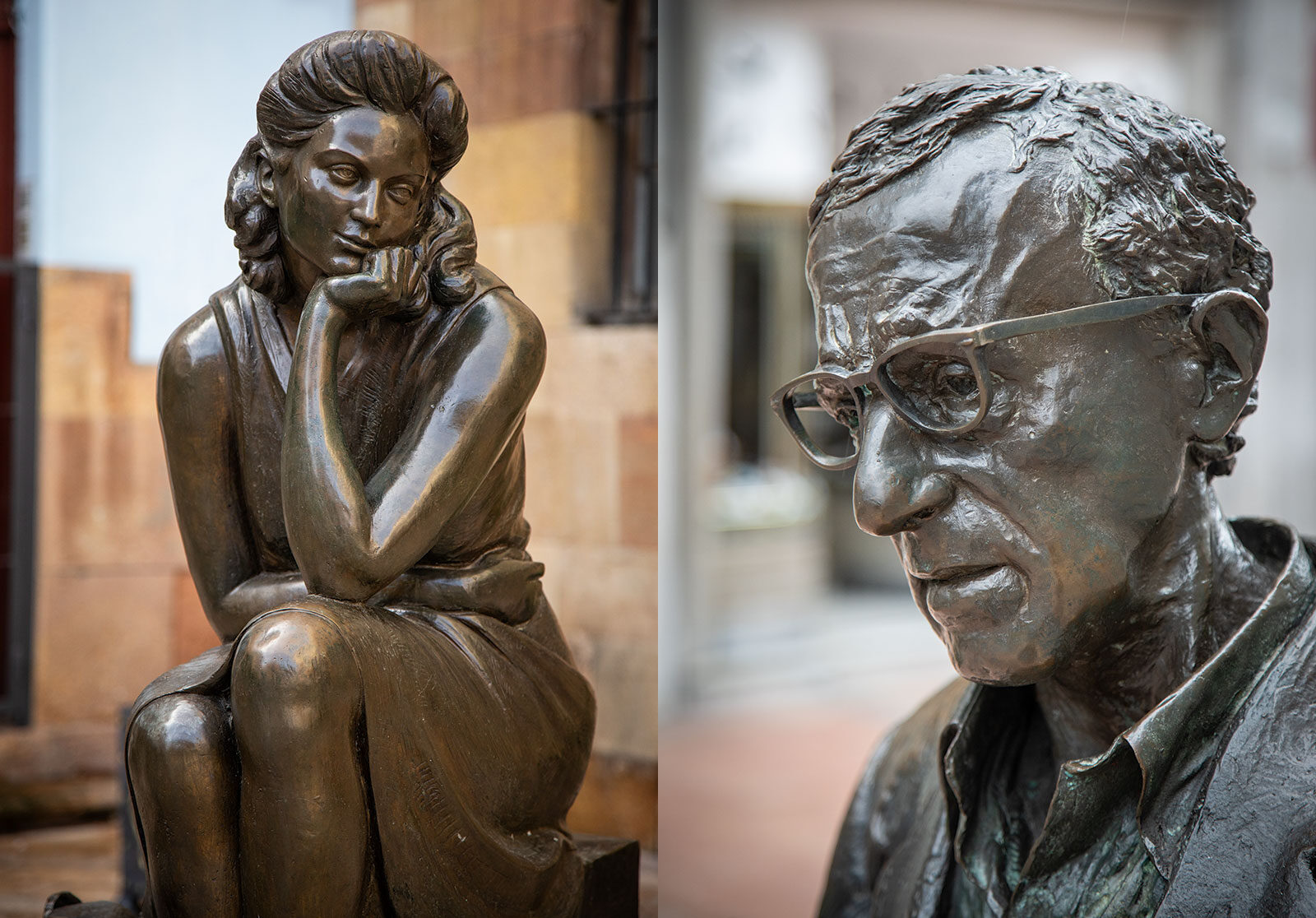
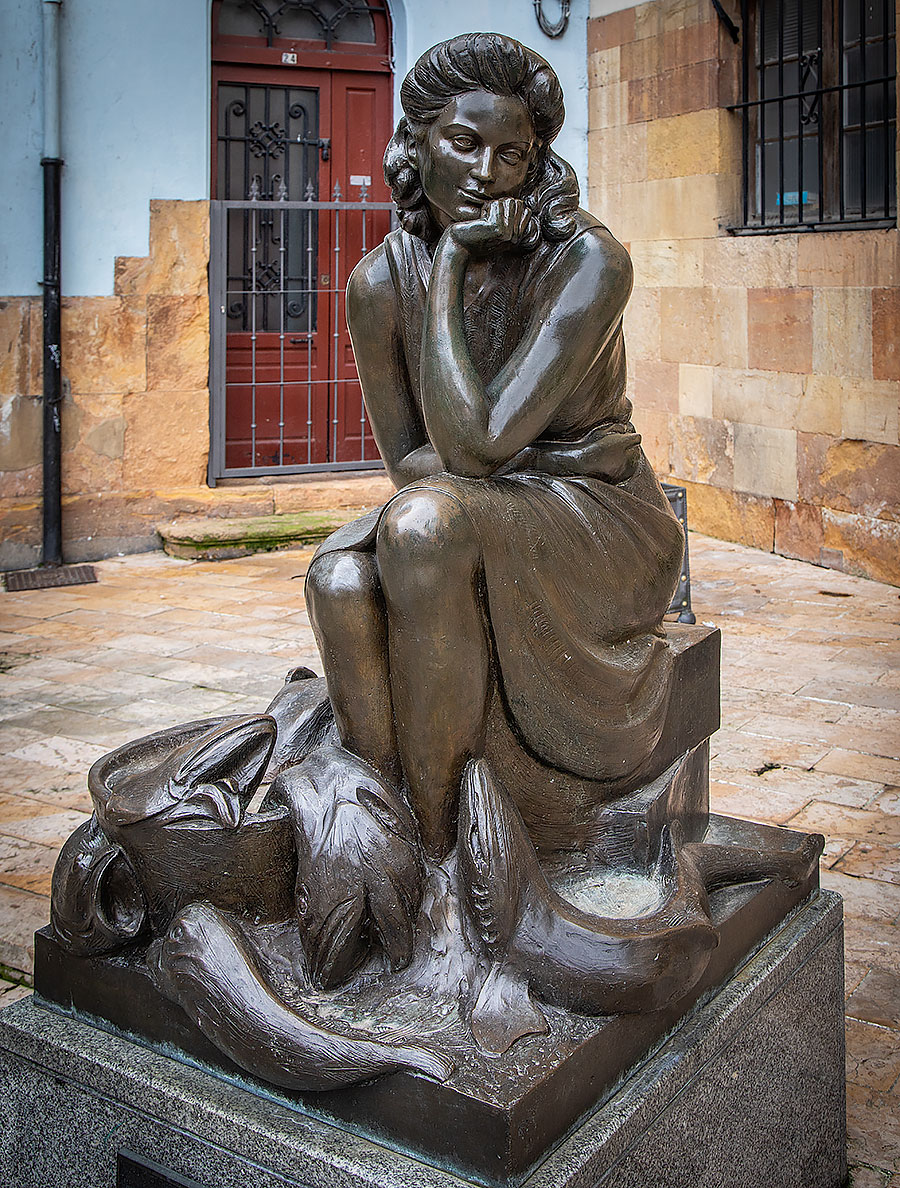 7 The fishergirl
7 The fishergirl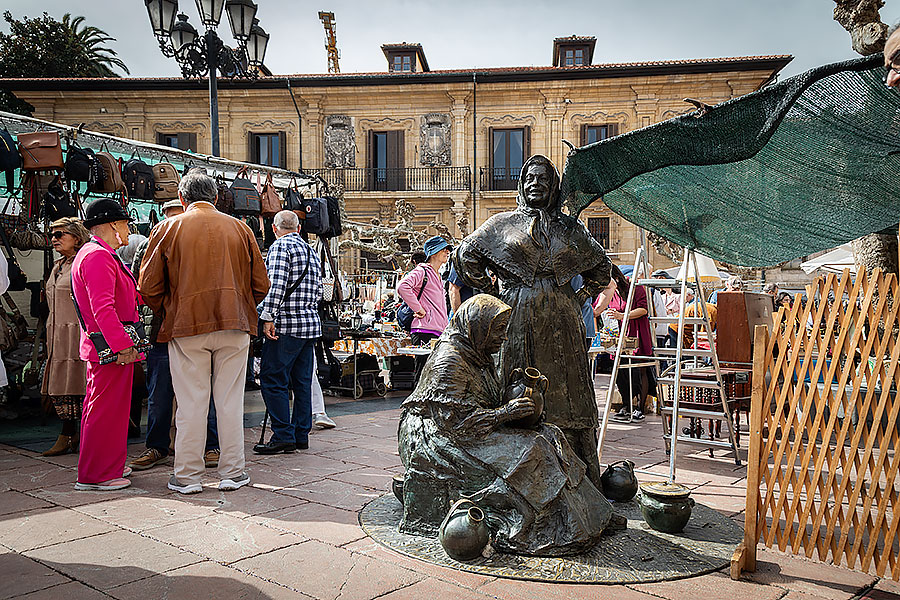 8 The sellers in the marketplace
8 The sellers in the marketplace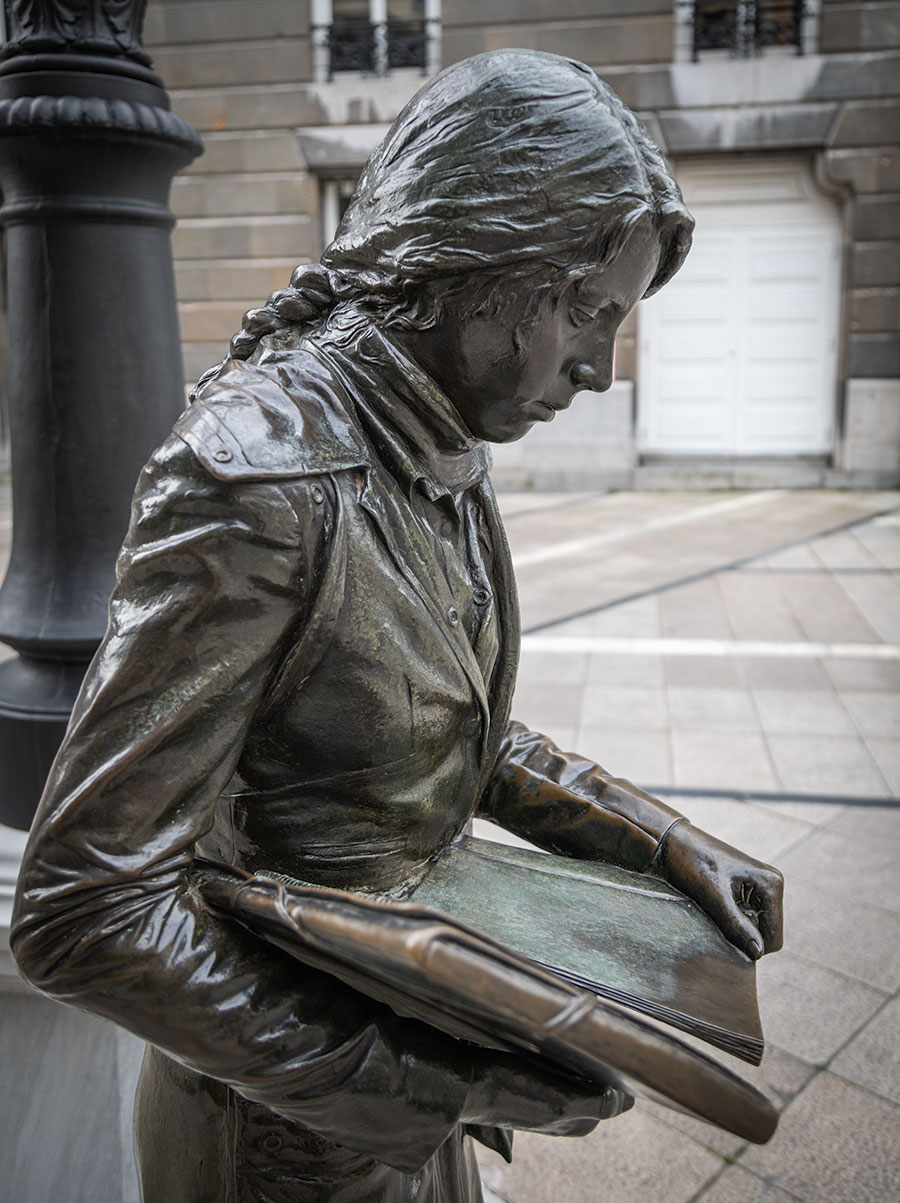 9 Young women reading
9 Young women reading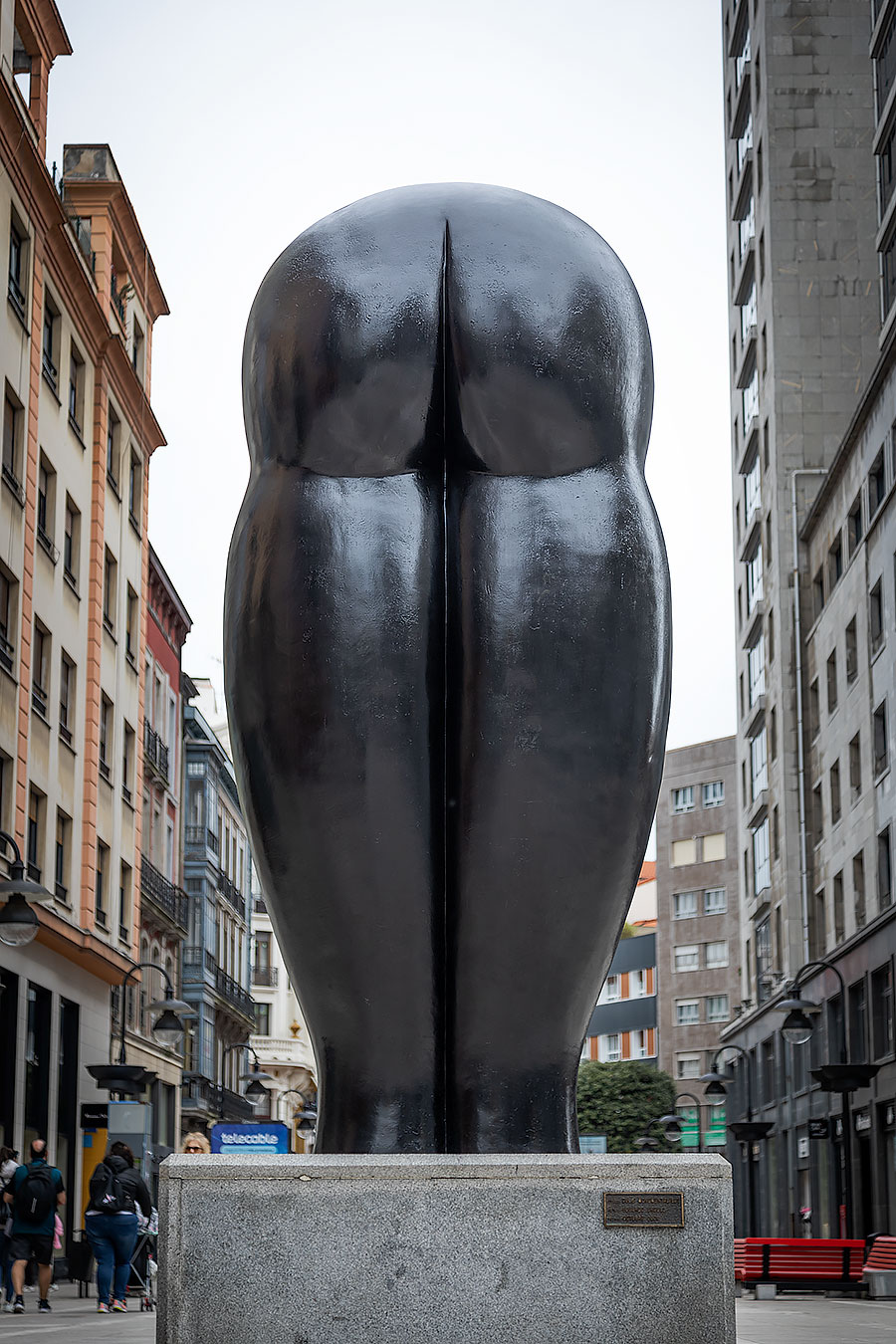 10 A good ass
10 A good ass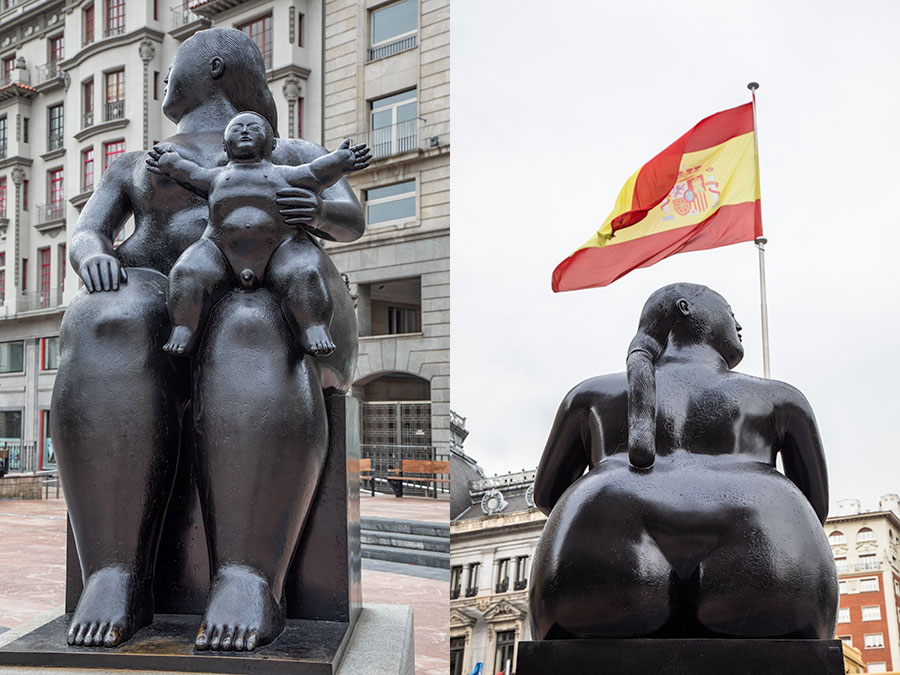 11 Tribute to moms
11 Tribute to moms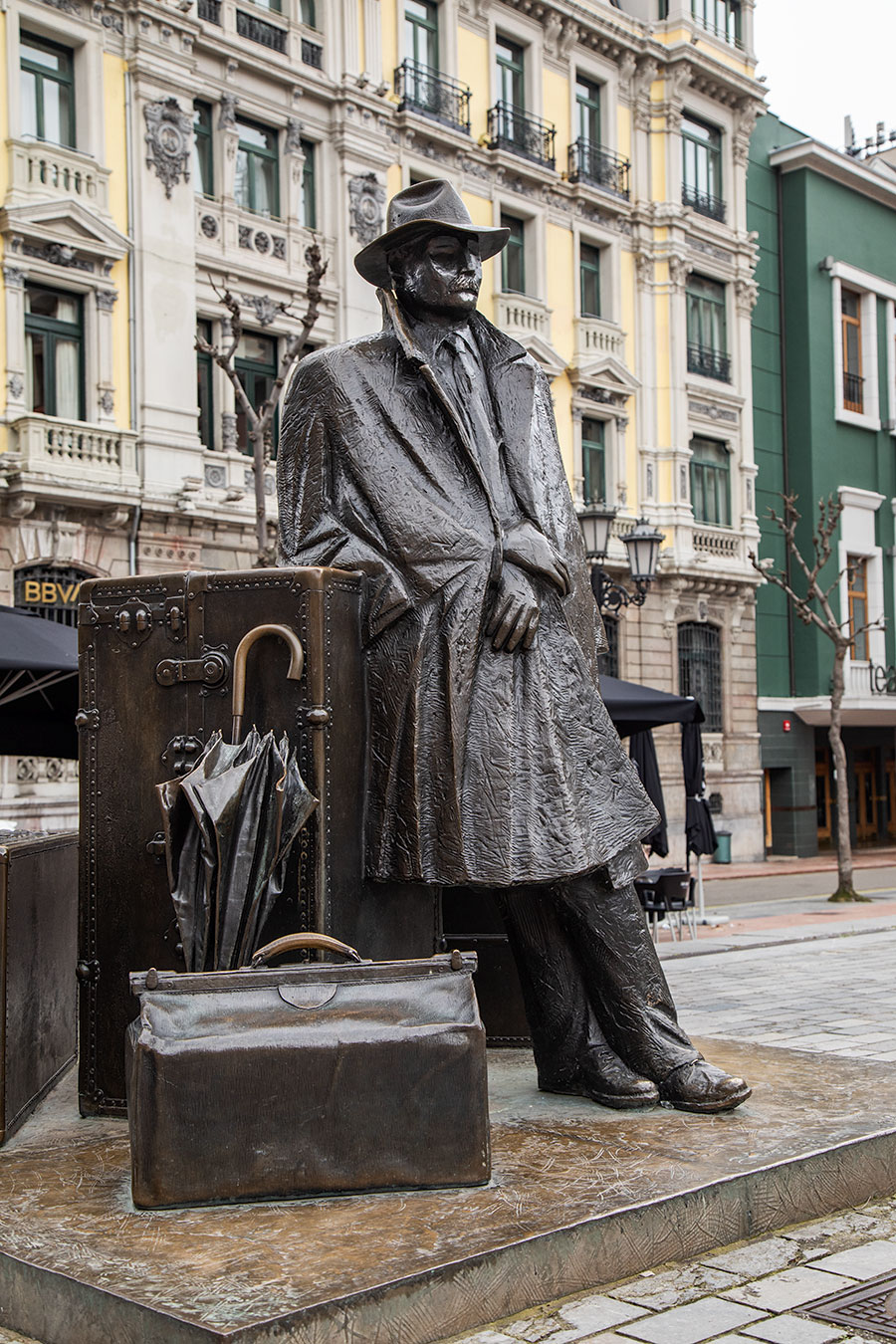 12 The mysterious traveler
12 The mysterious traveler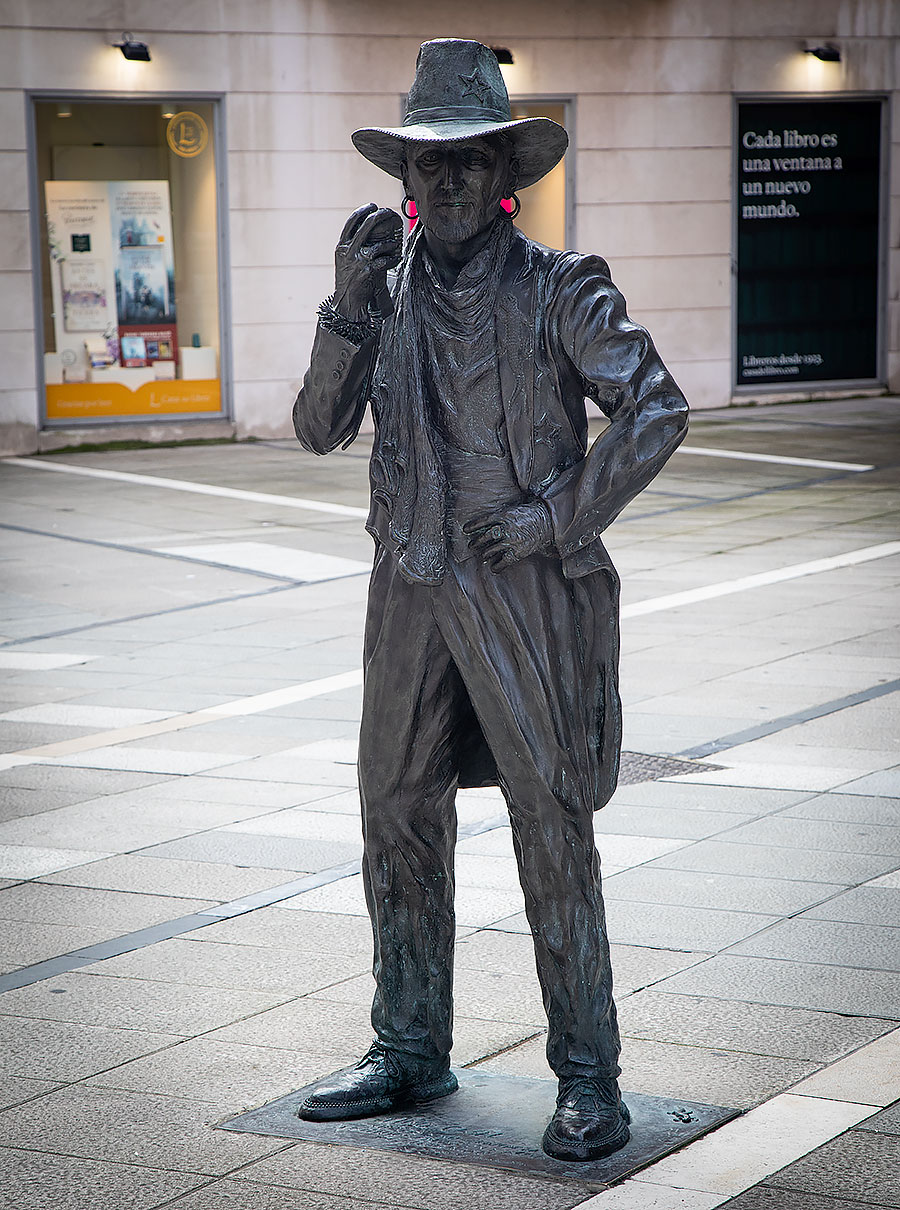 13 Tino Casal
13 Tino Casal 14 Demonstrative women and men
14 Demonstrative women and men